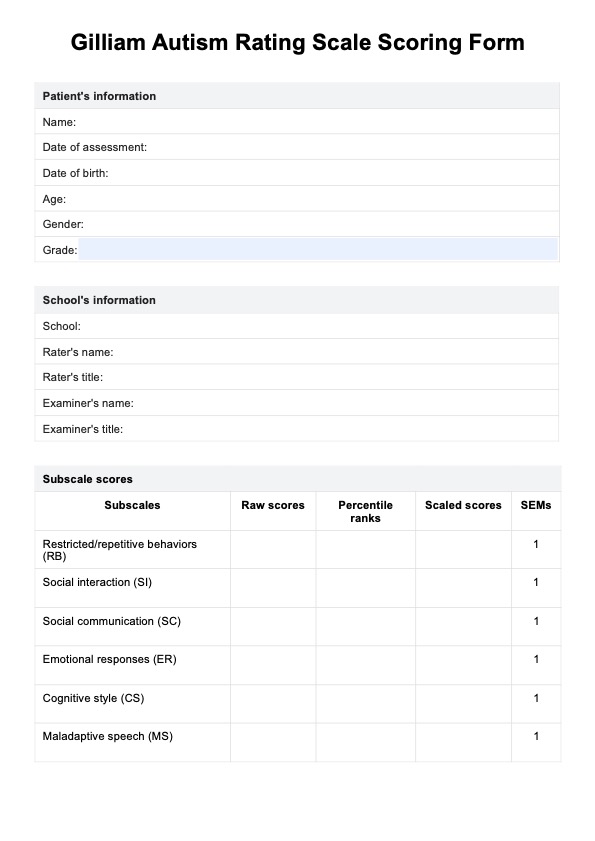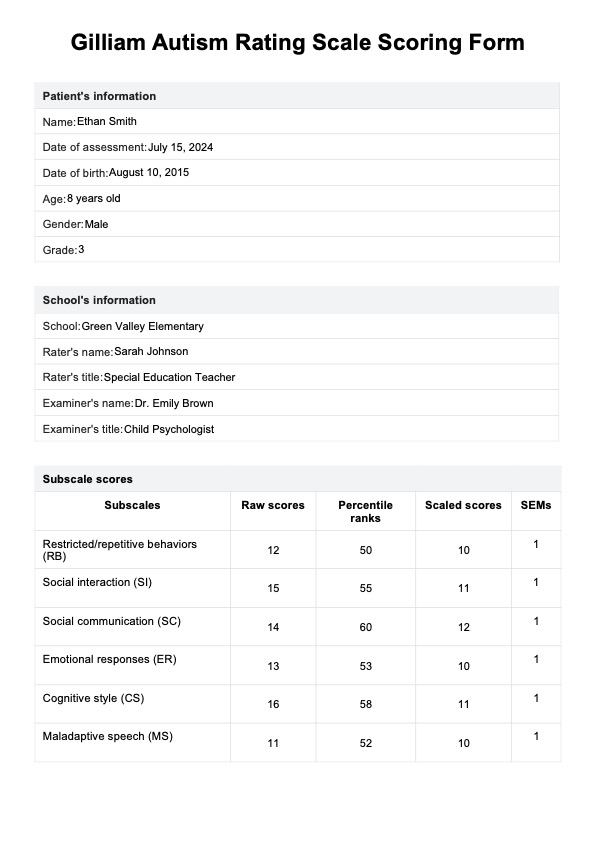Gilliam Autism Rating Scale
Explore the Gilliam Autism Rating Scale for assessing autism spectrum disorder in individuals aged 3-22. Download our free scoring sheet PDF here.


What is the Gilliam Autism Rating Scale?
Clinicians use the well-known diagnostic test Gilliam Autism Rating Scale (GARS) to assess and diagnose autism spectrum disorder (ASD), a category within broader mental disorders. Developed by James E. Gilliam, the GARS helps identify autism and quantify behaviors such as emotional responses, cognitive style, and characteristics of autism. This can help accurately discriminate children who have ASD and those who do not.
It also provides a standard measure for comparing these demographic characteristics and aligning with diagnostic and statistical manual criteria in individuals aged 3 through 22. The scale consists of various items that respondents, typically parents or professionals who know the child well, must rate based on the observed behaviors.
How is it scored?
The GARS uses a scoring system reflecting theoretical and empirical validity based on the frequency and intensity of specific autism-related behaviors, contributing to autism indexes. Each item on the scale is rated on a point system, typically from 0 (never observed) to 3 (frequently observed). These ratings are then compiled into subscales corresponding to different diagnostic criteria for autism, ensuring validity, internal consistency, and reliability coefficients exceed typical standards. The scores from these subscales are totaled to create a composite score that can suggest the likelihood of an ASD diagnosis. The higher the score, the greater the likelihood that the individual meets the criteria for autism.
Next steps after using this scale
After completing the Gilliam Autism Rating Scale and obtaining a score where autism indexes exceed expected ranges, the next steps typically involve:
- Reviewing the results: A qualified professional, such as a psychologist or psychiatrist, should review the scores to interpret what they indicate about the individual’s behavior and characteristics compared with the normative sample.
- Further assessment: If the GARS results, one of the most widely used instruments, suggest a potential autism diagnosis, further assessments may be necessary. This could include comprehensive developmental evaluations, interviews, and observations by specialists.
- Developing a plan: Based on the overall assessments, a tailored intervention plan should be developed. This plan might include behavioral therapies, educational accommodations, and possibly medical management.
- Monitoring and adjustment: The intervention plan should be regularly reviewed and adjusted as necessary to ensure it meets the changing needs of the individual as they grow and develop.
Gilliam Autism Rating Scale Template
Gilliam Autism Rating Scale Example
How to use our Gilliam Autism Rating Scale template
The Gilliam Autism Rating Scale is a copyrighted assessment tool. With that, we have created a scoring sheet template designed to assist clinicians in assessing autism spectrum disorders efficiently and effectively. The template is divided into several sections, each crucial for capturing distinct aspects of autism spectrum disorder adopted as the individual's behaviors and symptoms.
Step 1: Fill out information
Start by completing Section 1 with the individual's identifying information. This includes the name, date of the GARS-3 rating, date of birth, age, gender, grade, and school. Also, fill in details about the rater and the examiner, which helps contextualize the assessment.
Step 2: Conduct subscale assessments
Using your own instructional objectives manual, conduct the assessment with the individual and score based on your own observations.
Step 3: Score the assessment
Calculate the autism indexes and document it in the scoring sheet. This includes summing scaled scores and determining percentile ranks, the autism index, and the probability of ASD. These calculations help quantify the severity of the symptoms and the likelihood of an autism spectrum disorder diagnosis.
Step 4: Interpret the results
Interpret the autism index scores based on the information in your manual in relation to the probability of ASD and DSM-5 severity levels. This section helps determine the level of support the individual may need, ranging from minimal to very substantial support.
Benefits of using this scoring sheet template
The GARS scoring sheet template offers several benefits when well-known diagnostic tests assess ASD in individuals. Here are some of the key advantages:
- Streamlined data collection: The template provides a structured format for recording observations and ratings, ensuring that all necessary information is captured systematically. This organization helps prevent oversight of critical behavioral indicators.
- Efficient scoring process: With clearly defined sections for each domain and pre-formatted calculation areas, the scoring sheet facilitates quick and accurate tabulation of results. This efficiency can significantly reduce the time spent on administrative tasks post-assessment.
- Error reduction: The scoring sheet's structured layout minimizes the risk of calculation errors or misinterpretation of raw scores. This enhanced accuracy is crucial for reliable diagnosis and treatment planning.
- Visual clarity: The template typically includes visual aids such as boxes or grids, making tracking responses across different items and subscales easier. This clarity can be particularly helpful when reviewing or discussing results with colleagues or families.
- Consistency across evaluators: The scoring sheet provides a standardized format that promotes consistency in how practitioners record and interpret assessment data. This uniformity is especially valuable in settings where multiple clinicians may be involved in a patient's care.
Commonly asked questions
The GARS is designed to assess autism spectrum disorder in individuals aged 3 through 22 years.
The Gilliam Autism Rating Scale generally takes 5 to 10 minutes to complete, making it a quick tool for initial assessments.
While the GARS is useful for screening and assessing autism symptoms, it should not be used as the sole diagnostic tool. Comprehensive assessments, including clinical evaluations and additional testing, are necessary to accurately diagnose autism spectrum disorder.




















-template.jpg)



















































































